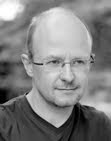Last Thursday I combined an afternoon appointment in London with a visit to Vision 2007, “the event for the aspiring and professional photographer” (organised by the British Journal for Photography, BJP). It’s target audience are mainly students that are graduating (or have just graduated) from photography colleges (I didn’t realise that when I registered). My main reason for going to the event was a 15 minute slot in the portfolio clinic. I took my Capitals booklet with me and a selection of “Mountain Portraits”. I was curious for the portfolio review but didn’t know what to expect otherwise. It turned into a very interesting and enjoyable day.
My portfolio reviewer turned out to be Niall O’Leary from Millennium Images (www.milim.com). This is a stock agency that tries to chart new waters in collecting much more personal work from photographers, targeted to clients that are looking for something different than the standard stock image. Many of their images end up on book covers. He reviewed the book very favourably, thought it was very well done, remarking that my approach looked “very photographic” and stressed that this was meant as a compliment. The panorama format made the pictures, however, unsuitable for Millennium. Apparently this format sells very difficult as clients don’t seem to know how to use it well. He also looked through the Mountain Portraits but seemed less captivated. “Actually, we would be interested in a portfolio that would be somewhere in between the two you have shown me just now.” He gave me a small, very neat Millennium catalogue and invited me to submit a collection of images if I thought there was a fit with the general line of the agency. On my return home I browsed through the catalogue and I think that, for example, my Mediterranean portfolio might be suitable for them. Something to be pursued.
When I took my leave of Niall, he waved to someone of the BJP, saying “this guy has interesting work.”. Promptly I was taken apart by Mick who invited me to participate in a BJP competition (but I couldn’t as I am not a UK citizen). He also invited me to submit a book which he would hand over to the editor of the BJP. They might well be interested in featuring some of my pictures in one of their future issues.
I managed to get another impromptu portfolio review by David Land, who is involved as an editor in two magazines: “f2 freelance photographer” and the Journal of the Royal Photographic Society. Again he was favourably impressed with the book, qualifying it as a convincing photographic project, well executed and potentially of interest to a wider audience. He thought it might very well make a good story for one of the journals. I left a book with him and he promised to follow up.
I also left a copy with Chris Dickie, the editor of yet another magazine: Ag. We didn’t have time for a long chat but he promised to get back to me with feedback.
My last copy of the Capitals booklet I left with Tom Hardy from Amazing Internet. I must have been one of their first clients when they started to offer attractive and flexible website packages for photographers a few years back. Sometime ago my first website “Mongolian Portfolio” morphed into the current topophotography.eu. I sat down with Tom who promptly suggested (and implemented) some improvements for my site: the layout was changed and the thumbnails resized with just a few clicks of the mouse. Great.
Vision 2007 also allowed me to stock up on shortdated Fuji film (at a price of 1 pound per roll): I bought 85 rolls of Reala, Superia 1600, 400CN and 160C (120 and 24x36 mixed). I spent some time looking at Olympus’ flagship DSLR, the E3 and at the Hasselblad CFV digital back (impressive, despite the obvious disadvantage of the 1,5x elongation factor). Spent some browing books at the Argentum stand, buying old copies at a fraction of the newsstand price. I was disappointed by the Thames & Hudson booth who only featured a ridiculously oversized book on Magnum photographers by Magnum photographers, sold at the price of 100 pounds sterling. It looks like Magnum is becoming a nice little cottage industry in itself, churning out an interminable stream of ever bigger books and corny merchandise, inflating its brand for mass-market appeal (Carl De Keyser and René Burri were there for talks but I didn’t go and listen to them). Oh, yes, Thames & Hudson offered a 20% discount on all their photography books but you can buy them with a 35% discount on Amazon.co.uk anyway …
Finally, I got to know two interesting print services – ThePrintSpace in London and Spectrum in Hove, East Sussex – which may turn out to be useful in the future. On the way back I visited Silverprint near Waterloo Station were I bought a box of Hahnemühle 308g A0 inkjet paper (ugh, expensive) and a box of A4 Photo Rag Pearl (even more expensive, if you don’t take into account the format). I also picked up a small stock of 220 Tri-X (320 asa) roll film. I haven’t worked with 220 before, but I think it is particularly interesting with 6x4.5 format cameras as it allows you to shoot almost 35 exposures on a roll. That comes close to the convenience of 24x36.
All in all a very rewarding visit with lots of leads to be further pursued.







